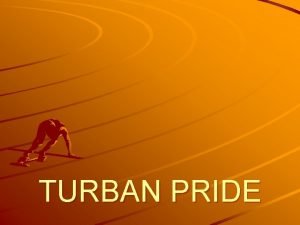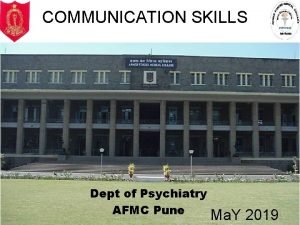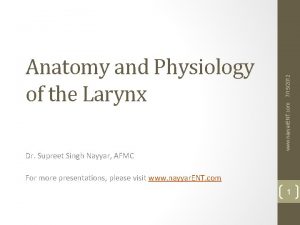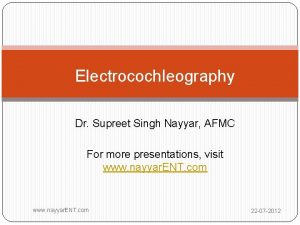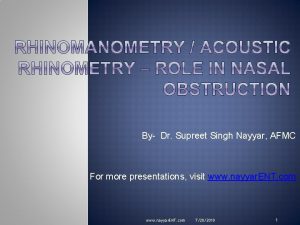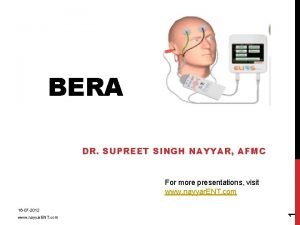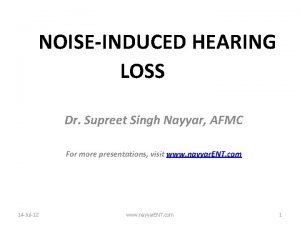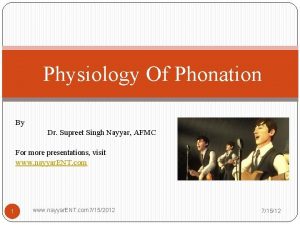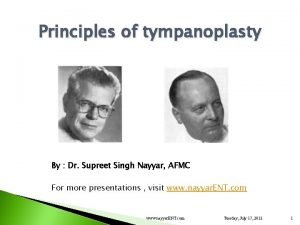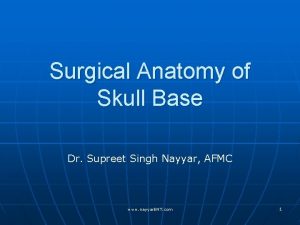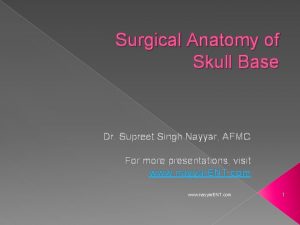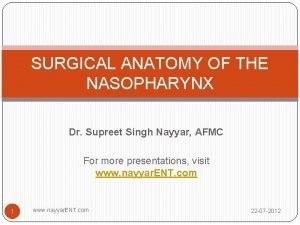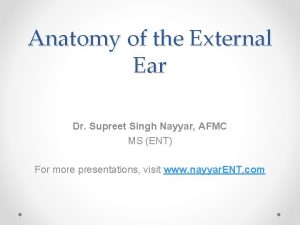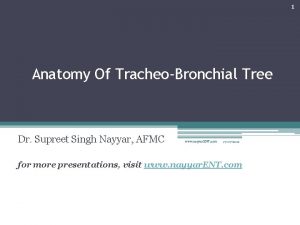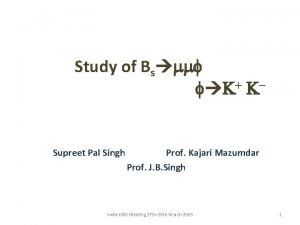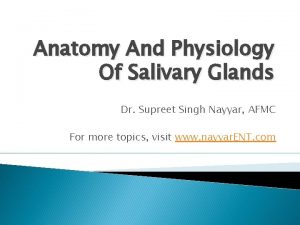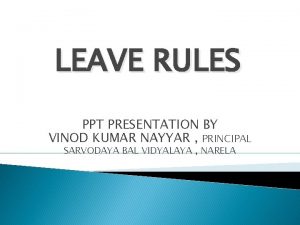Electronystagmography Dr Supreet Singh Nayyar AFMC For more





































- Slides: 37

Electronystagmography Dr. Supreet Singh Nayyar, AFMC For more ENT topics & ppts, visit www. nayyar. ENT. com 1 www. nayyar. ENT. com 28 -07 -2012

HISTORY � Rhythmical movement of eyes was known even in Ancient Greek medicine � Hippocrates, the father of medicine (460 B. C) & Galen (180 A. D) called it ‘Hippus’ which means small horse � Term ‘nystagmus’ was reserved for slow movement of the head � Berlin (1891) first attached a watch glass on the eye bulb to record nystagmus � Dodge & Clinc (1901) photographed light reflex from the eye & recorded nystagmus 2 www. nayyar. ENT. com 28 -07 -2012

VESTIBULAR REFLEX ARC � Sensory receptors: 3 cristae & 2 maculae � Afferent neuron: From the sensory cells to the vestibular nuclei � 2 nd order neurons: Vestibular nuclei to: �A) Oculomotor nuclei �B) Anterior horn cells of spinal cord �C) Cerebellar cortex �Temporal lobe cortex �Autonomic nervous system 28 -07 -2012 www. nayyar. ENT. com 3

VESTIBULO-OCULAR REFLEX � Stimulation of left ear with warm water (44ºC) � Stimulation of left labyrinth � Impulse to the VIth nerve of opposite side & IIIrd nerve of same side � Contraction of Rt LR & Lt MR leading to conjugate deviation of eyes to the right (slow phase) � Stimulation of reticular formation in brainstem � Counter the slow deviation of the eyes that jerk back to original position (fast phase) � Inhibition/facilitation: Cerebral cortex, cerebellum, reticular formation 4 www. nayyar. ENT. com 28 -07 -2012

FUNDAMENTALS OF ENG �Nystagmus �Continuous electrical processes in the retina �Electrical field created by positive corneoretinal potential �Coincides with the optical axis of the eye �Change with movement of the eye �Detected with the help of electrodes �Amplified & recorded on a running strip of paper/computer �Positive & negative deflection 5 www. nayyar. ENT. com 28 -07 -2012

28 -07 -2012 www. nayyar. ENT. com 6

ELECTRODE LOCATIONS 7 www. nayyar. ENT. com 28 -07 -2012

ELECTRONYSTAGMOGRAPH TRACING � Depends upon the machine � Monochannel/Multichannel � Sawtoothed curve � Criteria to identify nystagmus beats � Direction of nystagmus 28 -07 -2012 www. nayyar. ENT. com 8

Pendular Nystagmus Latent Period of Caloric Response www. nayyar. ENT. com 28 -07 -2012 Oblique Nystagmus Perversion 9

Visual Fixation Suppression Divergent Dissociation 28 -07 -2012 www. nayyar. ENT. com Failure of Visual Fixation Suppression Monocular Nystagmus 10

ENG PROCEDURE � ENG Room: quiet, lightproof � Away from heavy electrical equipments � ENG Machine: single/multi -channeled � Properly grounded � Bed/table/positioning chair � Head-end raised to 30º � Calibration cross/pendulum 28 -07 -2012 www. nayyar. ENT. com 11

� 2 thermostatically controlled caloric water baths � Irrigation apparatus � Air caloric irrigator � Optokinetic stimulator 12 www. nayyar. ENT. com 28 -07 -2012

PREPARATION OF THE PATIENT � Avoid alcohol & certain drugs 48 hrs before � Examination of the ears � Cleaning the area � Patient asked to lie down � Application of the electrodes �Silver, coated with non-polarizing silver chloride �Electrolyte paste should be applied �Should be firmly applied over the skin 13 www. nayyar. ENT. com 28 -07 -2012

CALIBRATION Electrical Calibration � 200 microvolt signal produces a 10 mm deflection � Amplitude of nystagmus: in microvolts � Depends on: corneoretinal potential � Frequency & Slow phase: independent 28 -07 -2012 www. nayyar. ENT. com 14

CALIBRATION Biocalibration � By using a pendulum � Mounted in a inverted fashion � Patient follows the movement for 10 cycles 28 -07 -2012 www. nayyar. ENT. com 15

OPTOKINETIC NYSTAGMUS TEST � Evaluates the optokinetic system � Passing before the patient's eyes a series of repetitive visual stimuli � Rotating drum/moving lights on a calibration bar � Vertical black stripes on a white background � Diameter of the drum: 8 inches � Height: 12 inches � Movement elicites nystagmus � Symmetry of responses is evaluated 16 www. nayyar. ENT. com 28 -07 -2012

THE POSITIONING NYSTAGMUS TEST � Elicit BPPV nystagmus � Recording 1 st in erect position for 30 secs � Position changed rapidly to head hanging position with head turned to the right for 30 secs � Turned to the erect position & recorded for 30 secs � Repeated on the left side � Nystagmus: rotatory with predominant vertical component � Done with both eyes open/closed 17 www. nayyar. ENT. com 28 -07 -2012

THE CALORIC TEST � Position: Supine � Head end of table: Raised by 30º � Ears irrigated with warm & cold water for 40 secs each � Nystagmus noted � Interval of 8 mins between 2 successive irrigations 28 -07 -2012 www. nayyar. ENT. com 18

PENDULUM TRACKING TEST � Evaluate optokinetic function of smooth pursuit � Tracks 10 stimulus cycles � Latter 5 are evaluated � Sway: 30º visual angle � Speed: less than 50º/sec � Records: 4 types 28 -07 -2012 www. nayyar. ENT. com 19

PENDULUM TRACKING TEST � Normal: 10 jerky beats superimposed on 5 pendulum cycles � Abnormal: >10 jerky beats (Lt/Rt) on 5 cycles � A) Normal tracing � B) Central lesion � C) Grossly disorganized/ataxic tracing…Advanced central lesion 28 -07 -2012 www. nayyar. ENT. com 20

SPONTANEOUS NYSTAGMUS TEST � Supine/ caloric position � 1 min recording of eyes closed nystagmus � Eyes open & asked to look straight… 1 min recording � Latter 30 secs is considered � Number of beats to Rt & Lt are counted � Co-ordination of 2 eyes is noted � Over 70% normal individuals may show nystagmus � Normal: upto 19 beats/30 secs in any direction � Abnormal: >19 beats/30 secs in any direction � Limited localization value 21 www. nayyar. ENT. com 28 -07 -2012

SPONTANEOUS NYSTAGMUS TEST Failure of Visual Fixation Suppression Direction changing Spontaneous Nystagmus Vertical Spontaneous Nystagmus Congenital Fixation Nystagmus 28 -07 -2012 www. nayyar. ENT. com 22

GAZE TEST � Patient is asked to look 30º to the right, left, up & down � Recording in each position � Duration: 30 mins � Nystagmus on gaze deviation � Always pathological � Differenciate from fatigue nystagmus 28 -07 -2012 www. nayyar. ENT. com 23

INTERPRETATION OF GAZE TEST � No nystagmus in any position: Normal � Right beating nystagmus in right lateral position: CNS pathology (cerebellar) � Left beating nystagmus in left lateral position: CNS pathology (cerebellar) � Gradually diminishing intensity of right/left beating nystagmus: Physiological end-point nystagmus � Rebound nystagmus: Chronic cerebellar pathology 24 www. nayyar. ENT. com 28 -07 -2012

POSITIONAL TEST � Static test to stimulate the otolith organs � Recording: for 1 min with eyes closed � Positions: sitting erect, supine with head turned left & right lateral, supine with head hyperextended � Non-specific evidence of vestibular disorder � Little localizing value � Significant: with eyes open/ 3 or more positions out of 7 � Positional nystagmus changing direction: CNS lesion � Factors affecting the nystagmus 25 www. nayyar. ENT. com 28 -07 -2012

Latency Benign Positional Nystagmus Central Positional Nystagmus 2 -10 sec None Adaptation Within 30 sec Persists Fatiguabilit Disappears on Persists y repetition Vertigo Persistent Absent/Mild Direction Undermost side Variable 28 -07 -2012 www. nayyar. ENT. com 26

QUANTITATIVE EVALUATION OF ENG 28 -07 -2012 www. nayyar. ENT. com 27

QUANTITATIVE EVALUATION OF ENG DURATION � Popular when nystagmus was directly observed � ENG: not a satisfactory parameter � Induced nystagmus declines over a period of time � Difficult to identify the end point accurately � Nystagmus reactions of different intensity may have same duration 28 -07 -2012 www. nayyar. ENT. com 28

QUANTITATIVE EVALUATION OF ENG Maximum Slow Phase Velocity � Widely used parameter � True representative of vestibular activity � Manual calculation: Bias 28 -07 -2012 www. nayyar. ENT. com 29

QUANTITATIVE EVALUATION OF ENG Culmination Frequency � Fq of nystagmus in culmination phase of caloric response � Simple & accurate measurement � Minimal personal error � Indicated as: No. of beats/30 sec � Midpoint: Culmination point (b/w 50 -110 sec) � Delay: Central pathology 28 -07 -2012 www. nayyar. ENT. com 30

CLAUSSEN’S BUTTERFLY CHART � Pictorial representation of caloric testing � Represented in 4 quadrants showing caloric response in each ear � Horizontal axis: represents time � Vertical axis: no. of nystagmus beats � Readings shown as normal (0), hypoactive (1) and hyperactive (2) �Normal 19 beats/ 30 sec = 0 �Hypoactive < 19 = 1 �Hyperactive >19 = 2 � Made for easier and faster interpretation 31 www. nayyar. ENT. com 28 -07 -2012

Normal Range �Rt 44˚ : 22 – 59 beats / 30 sec �Lt 44˚ : 23 – 63 beats / 30 sec �Rt 30˚ : 24 – 67 beats / 30 sec �Lt 30 ˚: 27 – 68 beats / 30 sec �Minor & major butterfly 28 -07 -2012 www. nayyar. ENT. com 32

28 -07 -2012 www. nayyar. ENT. com 33

DIGITAL ENG � Accurate calculation � Minimal unwanted artifacts � Good quality ENG record � Convenient TELEMETRIC � Time 7 place independent recording by patient himself � Specially developed goggles � Connected to recording device 34 www. nayyar. ENT. com 28 -07 -2012

THE ROTATORY TESTS � Concept of ‘retinal slip’ � Prevented in normal person by VOR � Rotatory test thus tests this VOR � Conducted in special chairs � !st carried out by Barany � Present method: Torsion swing chair � Asymmetry suggests vestibular pathology � Slow harmonic acceleration test 28 -07 -2012 www. nayyar. ENT. com 35

VIDEONYSTAGMOGRAPHY � Recording of eye movements by camera � Artifacts are non existent � Can record rotational nystagmus � Advantages & disadvantages over ENG 28 -07 -2012 www. nayyar. ENT. com 36

THANK YOU for more ENT ppts & topics, visit www. nayyar. ENT. com 37 www. nayyar. ENT. com 28 -07 -2012
 Lirik lagu more more more we praise you
Lirik lagu more more more we praise you More more more i want more more more more we praise you
More more more i want more more more more we praise you Jde summit
Jde summit Dr nayyar kazmi
Dr nayyar kazmi Raj birk
Raj birk Afmc organizational chart
Afmc organizational chart Afmc portal
Afmc portal What is afmc
What is afmc Knowing more remembering more
Knowing more remembering more The more you study the more you learn
The more you study the more you learn More love to thee o lord
More love to thee o lord Aspire not to have more but to be more
Aspire not to have more but to be more Human history becomes more and more a race
Human history becomes more and more a race More choices more chances
More choices more chances Newton's first law of motion examples
Newton's first law of motion examples 5 apples in a basket riddle
5 apples in a basket riddle Jag har nigit för nymånens skära
Jag har nigit för nymånens skära Inköpsprocessen steg för steg
Inköpsprocessen steg för steg Hur stor skarns är det för ett barn att få cancer
Hur stor skarns är det för ett barn att få cancer Strategi för svensk viltförvaltning
Strategi för svensk viltförvaltning A gastrica
A gastrica Novell typiska drag
Novell typiska drag Standardavvikelse formel
Standardavvikelse formel Tack för att ni har lyssnat
Tack för att ni har lyssnat Läkarutlåtande för livränta
Läkarutlåtande för livränta Treserva lathund
Treserva lathund Hur skriver man en debattartikel
Hur skriver man en debattartikel Påbyggnader för flakfordon
Påbyggnader för flakfordon Tack för att ni lyssnade
Tack för att ni lyssnade En lathund för arbete med kontinuitetshantering
En lathund för arbete med kontinuitetshantering Tobinskatten för och nackdelar
Tobinskatten för och nackdelar Egg för emanuel
Egg för emanuel Tack för att ni har lyssnat
Tack för att ni har lyssnat Programskede byggprocessen
Programskede byggprocessen Rutin för avvikelsehantering
Rutin för avvikelsehantering Mitos steg
Mitos steg Presentera för publik crossboss
Presentera för publik crossboss Rbk mätning
Rbk mätning




